7 Biodiversity
What is biodiversity?
Conservation biology aims to improve the protection of biodiversity—that is, all the species, genetic diversity, and ecosystems on Earth. By this definition, the process of documenting life on Earth requires us to consider biodiversity on three different levels (Figure 7.1):
Species diversity: The full variety of species, from single-celled organisms like bacteria to larger multicellular organisms like animals and everything in between.
Genetic diversity: The full range of variability in genetic material within a species. This variation can occur spatially as differences between populations or as differences between individuals of the same population.
Ecosystem diversity: The full variety of ecosystems—i.e., assemblages of species and the physical environments in which they live.
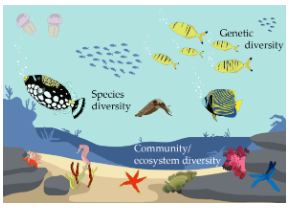
Figure 7.1: A region’s biodiversity includes the full complement of that area’s species diversity (all the area’s species), genetic diversity (the full range of genetic variation found within each of those species), and ecosystem diversity (the variety of ecosystems and ecological processes). CC BY 4.0.
Types of biodiversity
Scientists generally accept that the term biodiversity describes the number and kinds of species in a location or on the planet. Species can be difficult to define, but most biologists still feel comfortable with the concept and are able to identify and count eukaryotic species in most contexts. Biologists have also identified alternate measures of biodiversity, some of which are important for planning how to preserve biodiversity.
Species diversity
In general, the first step in responding to the conservation need of a species or population is to know its identity. For this reason, one of the three main goals of conservation biology is to document all life on Earth or, in plain language, to give each species a name. The task of giving each species a (formal) name falls on specialist scientists known as taxonomists. Taxonomists (and the people assisting them) explore nature, collect specimens of plants, animals, and other organisms, describe/name those specimens, and store the specimens in permanent collections, such as natural history museums and herbaria (there are currently over 6,500 natural history museums in the world). These permanent collections, affectionally called “Libraries of Life”, provide the material and locations that taxonomists use to describe species and to develop systems for biodiversity classifications.
When a species is formally described, it is given a unique two-part name, known as a binomial name. For example, the binomial name for the lion is Panthera leo. The first part of the name, Panthera, identifies the generic epithet (or simply genus); in this case, the panthers or big cats. The second part of the name, leo, identifies a subset within the genus known as the specific epithet (or simply species); in this case, the lion. This binomial system thereby both identifies a lion as its own species and connects it to other closely-related species: Africa and Asia’s leopards (P. pardus, VU); Asia’s snow leopard (P. uncia, VU); Asia’s tigers (P. tigris, EN); and South America’s jaguars (P. onca, NT) (Figure 7.2).
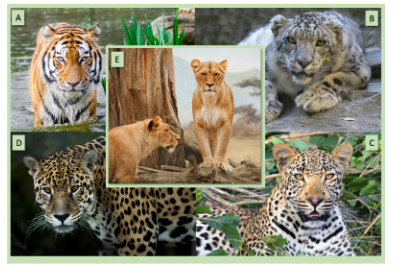
Figure 7.2: The world’s large predatory cats: (A) tiger, (B) slow leopard, (C) leopard, (D) jaguar, and (E) lion. By looking at their binomial names one can immediately see the five species are closely related. CC BY 4.0.What is a species?
There are three rules of thumb that taxonomists use to describe a species:
Morphological definition of species: Individuals that are distinct from other groups in their morphology, physiology, or biochemistry.
Biological definition of species: Individuals that breed (or could breed) with each other in the wild, but do not breed with members of other groups.
Evolutionary definition of a species: Individuals that share a common evolutionary past, usually indicated by genetic similarities.
In practice, conservation biologists generally rely on the morphological definition to identify species. The ability to recognize physical or morphological differences between organisms is handy even when the actual identity of specimens is unknown. In such cases, field biologists may refer to the unknown species as morphospecies (Figure 7.3), at least until an expert identifies the unknown individuals or a taxonomist gives them an official scientific name. In contrast, the biological definition of species relies on information that is difficult to obtain and thus not readily available. The biological definition also fails to recognize recent speciation, which can cause closely related but distinct species to interbreed. Similarly, it is generally impractical for fieldworkers to measure differences in genetic sequences to distinguish one species from another because these procedures currently require expensive, immovable laboratory equipment.
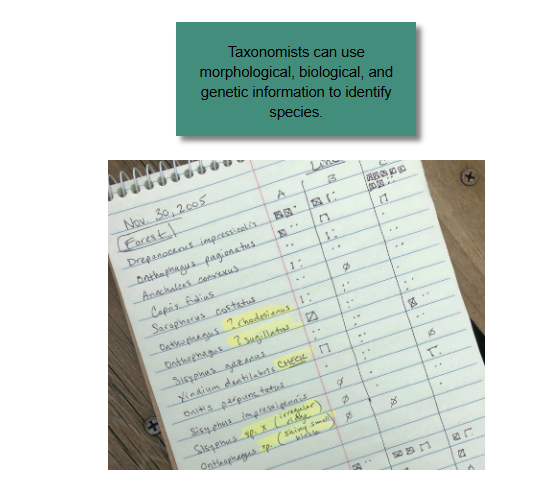
Figure 7.3: Field sheet showing application of the morphospecies concept during a dung beetle surveys in South Africa. Unidentified (and potentially misidentified) specimens are noted with a variety of descriptors (highlighted) and collected for identification at a later stage. Photograph by Lesley Starke, CC BY 4.0.
Genetic diversity
Genetic diversity or variation is the raw material for adaptation in a species. A species’ future potential for adaptation depends on the genetic diversity held in the genomes of the individuals in populations that make up the species. The same is true for higher taxonomic categories. A genus with very different types of species will have more genetic diversity than a genus with species that look alike and have similar ecologies. If there were a choice between one of these genera of species being preserved, the one with the greatest potential for subsequent evolution is the most genetically diverse one. It would be ideal not to have to make such choices, but, increasingly, this may be the norm.
Many genes code for proteins, which in turn carry out the metabolic processes that keep organisms alive and reproducing. Genetic diversity can be measured as chemical diversity in that different species produce a variety of chemicals in their cells, both the proteins as well as the products and by-products of metabolism. This chemical diversity has potential benefits for humans as a source of pharmaceuticals, so it provides one way to measure diversity that is important to human health and welfare.
Humans have generated diversity in domestic animals, plants, and fungi. This diversity is also suffering losses because of migration, market forces, and increasing globalism in agriculture, especially in heavily populated regions such as China, India, and Japan. The human population directly depends on this diversity as a stable food source; its decline is troubling to biologists and agricultural scientists.
Ecosystem diversity
It is the number of different ecosystems on the planet or in each geographic area. Whole ecosystems can disappear even if some of the species might survive by adapting to other ecosystems. The loss of an ecosystem means the loss of interactions between species, the loss of unique features of co-adaptation, and the loss of biological productivity that an ecosystem can create. An example of a largely extinct ecosystem in North America is the prairie ecosystem. Prairies once spanned central North America from the boreal forest in northern Canada down into Mexico. Now, they have mostly disappeared, replaced by crop fields, pasture lands, and suburban sprawl. Many of the species survive, but the hugely productive ecosystem that was responsible for creating the most productive agricultural soils is now gone. Consequently, soils are disappearing or must be maintained at greater expense.
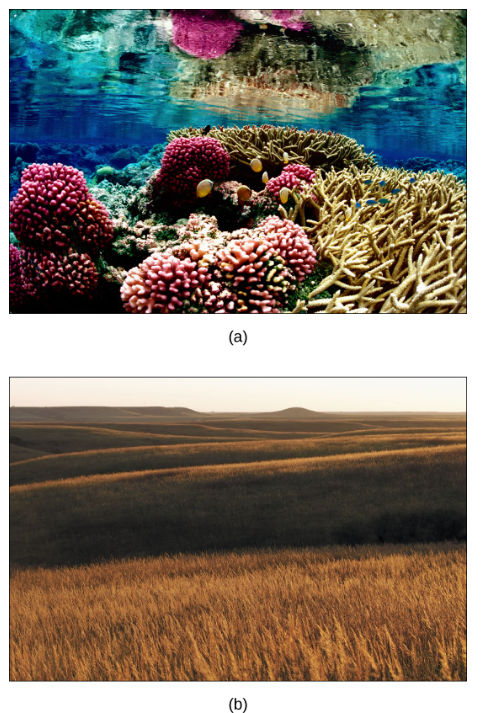
Figure 7.4: Ecosystem diversity – The variety of ecosystems on earth, from (a) coral reef to (b) prairie, enables a great diversity of species to exist.
Diversity Indices
A diversity index is a quantitative measure that reflects how many different types (such as species) there are in a dataset (a community). These indices are statistical representations of biodiversity in different aspects (richness, evenness, and dominance). When diversity indices are used in ecology, the types of interest are usually species, but they can also be other categories, such as genera, families, functional types, or haplotypes. The entities of interest are usually individual plants or animals, and the measure of abundance can be, for example, number of individuals, biomass or coverage.
Richness simply quantifies how many different types of the dataset of interest contains. For example, species richness (usually noted S) of a dataset is the number of species in the corresponding species list. Richness is a simple measure, so it has been a popular diversity index in ecology, where abundance data are often not available for the datasets of interest.
Although species richness (denoted S) is often used as a measure of biodiversity, of more interest to ecologists and conservation biologists are diversity indices that include both species richness and measures of abundance. This is because richness alone does not account for evenness across species.
Biodiversity at different scales- Alpha, Beta, and Gamma
Biologists have developed three quantitative measures of species diversity as a means of measuring and comparing species diversity:
Alpha diversity (or species richness), the most referenced measure of species diversity, refers to the total number of species found in a particular biological community, such as a lake or a forest. Bwindi Forest in Uganda, with an estimated 350 bird species, has one of the highest alpha diversities of all African ecosystems.
Gamma diversity describes the total number of species that occur across an entire region, such as a mountain range or continent, that includes many ecosystems. The Albertine Rift, which includes Bwindi Forest, has more than 1,074 species of birds, a very high gamma diversity for such a small region.
Beta diversity connects alpha and gamma diversity. It describes the rate at which species composition changes across a region. For example, if every wetland in a region was inhabited by a similar suite of plant species, then the region would have low beta diversity; in contrast, if several wetlands in a region had plants communities that were distinct and had little overlap with one another, the region would have high beta diversity. Beta diversity is calculated as gamma diversity divided by alpha diversity. The beta diversity for forest birds of the Albertine Rift is about 3.0, if each ecosystem in the area has about the same number of species as Bwindi Forest.
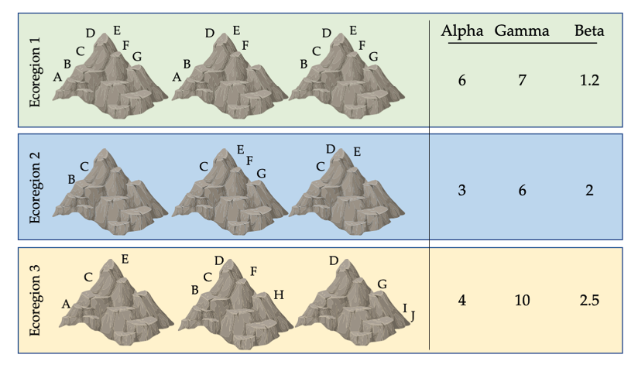
Figure 7.5: Biodiversity indices for nine mountain peaks across three ecoregions. Each symbol represents a different species; some species have populations on only one peak, while others are found on two or more peaks. The variation in species richness on each peak results in different alpha, gamma, and beta diversity values for each ecoregion. This variation has implications for how we divide limited resources to maximize protection. If only one ecoregion can be protected, ecoregion 3 may be a good choice because it has high gamma (total) diversity. However, if only one peak can be protected, should a peak in ecoregion 1 (with many widespread species) or ecoregion 3 (with several unique, range-restricted species) be protected? After Primack, 2012, CC BY 4.0.
It is important to note that alpha, beta, and gamma diversity describe only part of what is meant by biodiversity. For example, none of these three terms completely account for genetic diversity, which allows species to adapt as conditions change. It also neglects the importance of ecosystem diversity, which results from the collective response of species to their dynamic environment. However, these diversity measures are useful for comparing different regions and identifying locations with high concentrations of native species that should be protected.
How many species are there?
To date, taxonomists have described about 2.2 million species that share this planet with us (http://www.catalogueoflife.org/annual-checklist/2019/info/about). While this total may seem impressive, available evidence suggests that this estimate vastly underestimates the true extent of Earth’s biodiversity. In fact, even now, after all the exploration in years gone by, several thousand new species are being described each year. Many new discoveries are made by skilled researchers recognizing new species by being able to discern variation in morphological characters; that includes the discoveries of a new small forest antelope from West Africa (Colyn et al., 2010) and a new species of shark off Mozambique (Ebert & Cailliet, 2011). New genetic technologies have highlighted that there are many thousands of species yet to be described. Both traditional and genetic techniques rely heavily on the availability of specimens in Natural History Museums collections to help identify and describe new species (Sforzi et al., 2018). A lack of taxonomists and natural history collections in many of the world’s most biodiverse countries means there is a still a great deal of work to do (Paknia et al., 2015).
The most exciting and newsworthy discoveries of new species generally involve higher-level taxa, especially living fossils. For example, in 1938, biologists across the world were stunned by the report of a strange fish caught in the Indian Ocean off South Africa. This fish, subsequently named coelacanth Latimeria chalumnae, belongs to a group of marine fishes that were common in ancient seas but were thought to have gone extinct 65 million years ago. Coelacanths are of interest to evolutionary biologists because they show certain features of muscles and bones in their fins that are comparable to the limbs of the first vertebrates that crawled onto land. Following the initial discovery, coelacanths have been found along Africa’s Indian Ocean coast from South Africa to the Comoros and through to Kenya. Unfortunately, the entire coelacanth population, estimated at fewer than 500 individuals, is currently highly threatened because of ongoing fishing pressures (Musick, 2000).
Although field surveys have proven to be of great importance for discovering new species and populations, perhaps the greatest taxonomic progress has come from advances in genetic analyses which help to separate cryptic species previously lumped under more widespread species. Similarly, using new genetic methods, scientists recently confirmed that the slender-snouted crocodile Mecistops cataphractus consists of two different species, one endemic to West Africa and the other to Central Africa (Shirley et al., 2018).
Estimates suggest there are somewhere between 1–6 billion distinct species on Earth. The most diverse group of species is bacteria.
The presence of so many undiscovered species and communities makes precise estimates of species diversity incredibly difficult, especially in Africa where so many areas remain scientifically unexplored. Our most recent estimates, combining genetic analysis of well-known groups with mathematical patterns, suggests there are between 1–6 billion distinct species on Earth (Table 6.1) of which there are only about 163 million animals and 340 thousand plants (Larsen et al., 2017)—this is obviously much greater than the current catalog of almost 2 million species!
Table 6.1: Estimated living biomass and number of species for each kingdom of life, following the seven-kingdom system (Ruggiero et al., 2015). Note how plants weigh the most, but bacteria have the most species. a As gigatonnes of carbon, from Bar-On et al., 2018, b From Larsen et al. (2017)’s Table 1, Scenario 1 and c from http://www.catalogueoflife.org
|
Kingdom |
Weight (Gt)a |
Number of species (in million) |
% of all species b |
Number of described species c |
% of described species |
|
Animals |
2 |
163 |
7 |
1,205,336 |
<1 |
|
Fungi |
12 |
165 |
7 |
135,110 |
<0.01 |
|
Plants |
450 |
0.382c |
< 0.5 |
364,009 |
95 |
|
Chromista |
Unknown |
0.025c |
< 0.5 |
23,428 |
94 |
|
Protozoans |
4 |
163 |
7 |
2,686 |
0.1 |
|
Archaea |
7 |
0.0005 |
< 0.5 |
377 |
75 |
|
Bacteria |
70 |
1,746 |
78 |
9,982 |
0.1 |
Contributors and Attributions
Modified from the following sources:
Ecology for All! By LibreTexts, Chapter 22.1, Chapter 22.2, and Chapter 22.4 licensed CC BY-NC-SA
Conservation Biology in Sub-Saharan Africa by J.W. Wilson and R.B. Primack Chapter 3 licensed CC BY 4.0
Additional references and citations from the above sources can be found in References in the backmatter.
7. Biodiversity is shared under a CC BY-NC-SA license

